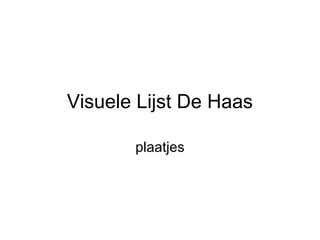Visuele lijst de haas
- 1. Visuele Lijst De Haas plaatjes
Editor's Notes
- #27: the ten incarnations (called Dashavatar)
- #30: The Day of Ashura, (10th day of Muharram), day of mourning in Shi'a Islam
- #31: The Great Buddha Kamakura Japan
- #43: Saint Ignatius of Antioch Episcopal Church Bharat Bhavan: Cambridge Hindu ShrineÂ
- #58: This picture is not of a sundial. It is an intricate representation of the Dharmachakra, or Buddhist Wheel
- #61: View of the Shinto entrance torii taken from the Miyajima ferry. Photographed by contributor.
- #63: Egypte Mihrab de la Mezquita del SultÃĄn Hassan
- #64: Image of Joan of Arc Painted between 1450 and 1500 Centre Historique des Archives Nationales, Paris, AE II 2490
- #65: Salam A7'i Tomes; Here is the time to answer this. You are right, it has something to do with the Eid (3ed) which is (3ed al-a9'7a) in particular, the festival that comes within the 7aj time. The calligrapher wrote: 3ed a9'7a mobarak The word MOBARAK means Blessed,, so it says: Blessed 3ed ad9'7a Then there is the following famous Sentence in any yearly occasion which is Kol 3am wa antom be7âayr, means: every year comes with good for you (general meaning). The font is called Dewani, one of the most complex fonts in the Arabic calligraphy as well as one of the most elegant fonts. That was it,, if you have any pieces of Arabic calligraphy you want to ask about please add it in this forum and we'll do our best to answer  Salam Ehab
- #67: The Shaolin Temple was a Buddhist temple orginally built sometime between 386 and 534 A.D., but most agree that it was completed around 495 A.D. At its peak, the Shaolin Temple was one of the largest monestaries in all of China. A red brick wall enclosed rows of large halls and pagodas, as well as many smaller buildings. There were training halls, meditation halls, shrines, libraries, dormitories, and kitchens, as well as other buildings used for everyday life.
- #69: Kerststal Waasmont (BE)
- #73: Aakerk Groningen










































































